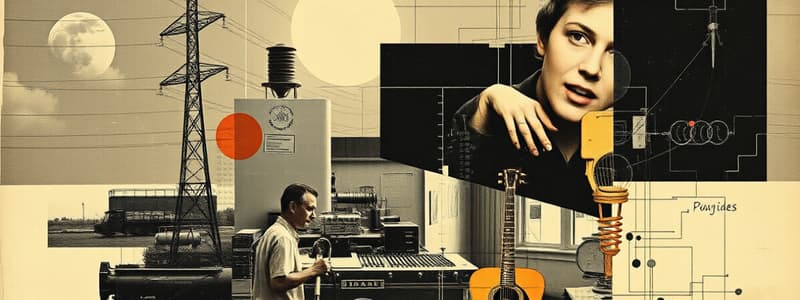Podcast
Questions and Answers
What is electricity?
What is electricity?
A form of energy that produces light, heat, magnetic and chemical changes.
What are electrons?
What are electrons?
Tiny negatively charged particles.
What is current?
What is current?
Flow of electrons along a path called a conductor.
What is cord safety?
What is cord safety?
Signup and view all the answers
What does AMP measure?
What does AMP measure?
Signup and view all the answers
What does VOLT measure?
What does VOLT measure?
Signup and view all the answers
What does OHM measure?
What does OHM measure?
Signup and view all the answers
What is a WATT?
What is a WATT?
Signup and view all the answers
What does HERTZ measure?
What does HERTZ measure?
Signup and view all the answers
What is electric current?
What is electric current?
Signup and view all the answers
What is direct current?
What is direct current?
Signup and view all the answers
What is alternating current?
What is alternating current?
Signup and view all the answers
What is a circuit?
What is a circuit?
Signup and view all the answers
What is parallel wiring?
What is parallel wiring?
Signup and view all the answers
What is series wiring?
What is series wiring?
Signup and view all the answers
What is an overload?
What is an overload?
Signup and view all the answers
What is a short circuit?
What is a short circuit?
Signup and view all the answers
What are safety devices?
What are safety devices?
Signup and view all the answers
What is thermal energy used for?
What is thermal energy used for?
Signup and view all the answers
What are the two forms of electric current?
What are the two forms of electric current?
Signup and view all the answers
Study Notes
Electricity Basics
- Electricity is a form of energy that can produce light, heat, magnetic, and chemical changes.
- Electrons are tiny negatively charged particles that are fundamental to electrical energy.
Current and Flow
- Electric current refers to the flow of electrons along a conductor.
- Current can be measured in Amperes (AMP), which indicates the number of electrons flowing in a line.
Measurements and Units
- Voltage (V) measures the pressure of electrons, with standard values of 110 or 220 volts in AC generators.
- Ohms (Ω) quantify resistance, indicating how difficult it is for electrons to flow through a conductor.
- Watts (W) measure the amount of energy used, with 1,000 watts equal to one kilowatt.
Frequency
- Hertz (Hz) indicates the frequency of cycles per second in an alternating current (AC), with 1 Hz equal to one cycle per second.
Types of Current
- Direct Current (DC) features electrons moving in one direction at a steady rate.
- Alternating Current (AC) allows electrons to flow first in one direction and then reverse back.
Circuit Concepts
- A circuit is a closed path through which electrons travel to power appliances.
- Parallel wiring allows multiple loads to be powered independently, while series wiring powers all loads in sequence.
Safety Considerations
- Cord safety is essential; cords should remain straight and untangled to prevent breaks and potential electric shocks.
- Overloading occurs when too many appliances draw power from a single circuit simultaneously.
Electrical Issues
- A short circuit happens when an unintended conductor contacts a wire carrying current, potentially causing malfunctions or hazards.
- Safety devices, containing fine metal wire, are integrated into circuits to help prevent overloads and short circuits.
Thermal and Other Forms of Current
- Thermal energy is generated during the flow of electricity.
- Electric current exists in two primary forms: Alternating Current (AC) and Direct Current (DC).
Studying That Suits You
Use AI to generate personalized quizzes and flashcards to suit your learning preferences.
Description
These flashcards cover the fundamental concepts of electricity, including key terms such as electric current and cord safety. Perfect for students looking to reinforce their understanding of electrical principles. Use them for quick revision or as a study aid.




